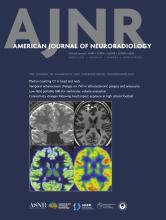We have read with interest the comment by Su et al and their own recent publication on this subject.1 Their results show that embolization with Onyx (Medtronic) is a feasible and safe method for embolization of anterior cranial fossa dural arteriovenous fistulas (ACF-dAVFs). However, we do not find it statistically reliable to compare these results (ie, occlusion and complication rates) with the results of our study. Furthermore, there are considerable differences in fistula angioarchitecture between our studies, for example middle meningeal artery contribution, present in 20% of cases in our study compared with 70% in the study by Su et al. In our study, the ophthalmic artery was the primary feeder of all ACF-dAVFs. Embolization through the ophthalmic artery differs from that of other arteries due to the proximity to the central retinal artery and the presence of so-called dangerous extracranial-intracranial anastomoses.2
A key property of nonadhesive liquid embolic agents such as Onyx or Squid (https://baltgroup.com/products/squid/) is that they can be used to embolize vessels irrespective of flow direction. Embolization using nonadhesive agents requires prolonged injection of the agent. When forward migration toward the fistulous point and draining vein fails, repeat injection (after an interval in which the agent can start to solidify) is necessary. During this process, penetration of the embolic agent in anastomosing vessels is common. This can even be enhanced using a balloon or pressure cooker technique. In the presence of dangerous anastomoses, such as the recurrent meningeal artery connecting to the ophthalmic artery, this effect is clearly undesirable and equally present whether embolizing through the aforementioned middle meningeal artery or sphenopalatine artery with anterior and posterior ethmoidal connections to the ophthalmic artery.
When embolizing through the ophthalmic artery, n-BCA dependence on flow direction is also favorable because it reduces retrograde reflux of embolic liquid. In our experience, use of diluted n-BCA is favorable when embolizing in proximity to extracranial-intracranial anastomoses. This use is corroborated by our results, because there were no incidences of retinal ischemia or visual symptoms in our study.
References
- © 2024 by American Journal of Neuroradiology












